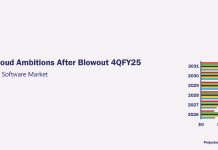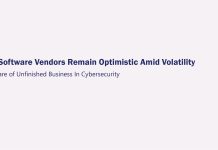
Behind the massive, showy and glitzy Dreamforce event that attracted over 100,000 attendees in San Francisco stood FinancialForce, a $124 million developer that delivers no-nonsense financial management applications.
FinancialForce shared the spotlight with Salesforce at the September event by renting out an entire Brazilian steakhouse nearby for a whole week, holding hundreds of meetings daily and serving an endless supply of steak, seafood and cocktails to clients, prospects and partners. The over the top marketing push followed the same playbook of Salesforce at every Dreamforce, underscoring the multi-faceted relationship between FinancialForce and its de-facto parent Salesforce, which is also its majority shareholder.
While the latter aims to appeal to the broadest base of customers possible, FinancialForce caters to a more narrow audience. Despite that, the future of Salesforce depends not just on the continued success of its CRM franchise, but perhaps more importantly its ability to increase wallet share among its customers through strategic partners like FinancialForce.
The relationship between Salesforce and Financialforce is similar to that of Netflix and its content creators. Even with a captive audience on a popular platform, Salesforce relies on developers like FinancialForce to build captivating programs so that there is little reason for its subscribers to go elsewhere for content.
FinancialForce is also an outlier in the ERP applications market offering a suite of Cloud-based financials mostly for professional service automation and related functions like billing, revenue recognition and subscription management, all tied to Salesforce for better visibility into customer history, current interactions and future opportunities.
Many FinancialForce users are business analysts who spend hours each day poring over billing records, customer updates and project milestones for fixed or variable payments – all within the confines of their legacy CRM application or the new Salesforce Lightning interface that integrates seamlessly into FinancialForce systems for invoicing, AR/AP, GL posting as well as financial reporting.
It’s a combination of heavy utilization and intense customer engagement that puts FinancialForce in a unique position of influencing the future of Salesforce.
Some FinancialForce customers would start off with the use of its software before they actually implement Salesforce because of the natural fit, while others actually prefer FinancialForce over any other financial management software because of its seamless integration into Salesforce. In other words, it doesn’t matter one puts peanut butter or jelly first, the sandwich is not complete without both.
So far, the special relationship between FinancialForce and Salesforce has bode well for both.
Since its founding in 2009 as a joint venture between Salesforce and ERP vendor Unit4 to help the latter accelerate its Cloud migration, FinancialForce has experienced consistent double-digit growth. More recently, Unit4 and PE firm Advent International have scaled back their investment in FinancialForce, while Salesforce and TCV Ventures have pumped millions more into the company.
Now with more than 1,350 customers, FinancialForce has focused primarily on professional services and not-for-profit verticals with increased presence among technology vendors like Cisco, HPE and Lexmark.
FinancialForce, whose offices are just a stone’s throw from Salesforce’s new 61-story headquarters in downtown San Francisco, saw its revenues soar to $124 million in fiscal 2019, up 38% from $90 million a year earlier. Almost 60% of its customers run multiple products for billing, revenue recognition and GL from FinancialForce, solidifying its usage and wallet share among a user population made up of professionals responsible for finance, sales, and customer operations.
At its recent CommunityLive event, Tod Nielsen, who became CEO of FinancialForce in January 2017 after heading the platform business at Salesforce for more than a year, said his priority is to grow FinancialForce into a $1-billion company over the next few years by positioning it as a key enabler for the services economy.
Nielsen said FinancialForce’s value lies in helping agile services companies by automating their every transaction, customer interaction and support mechanism to drive the best possible business outcome and financial results.
Since his appointment, Nielsen has made a number of new hires including Dan Brown, a former Microsoft Dynamics veteran, to run product development, and Fred Studer, a former NetSuite executive, to become FinancialForce CMO. The new management team has resulted in a heightened sense of urgency, bulking up its development resources in places like Grenada, Spain, and drumming up product enhancements.
During its CommunityLive event in June, FinancialForce unveiled improvements to its reporting, invoicing, payroll and time card integration, and financials modules in areas like cost amortization for revenue contracts, all designed to help customers standardize on its professional services automation, billing, revenue recognition and forecasting apps across all ERP core financials functions in order to maximize their benefits.
For example, Console Group cites using a full suite of FinancialForce applications has given the Australian software company better visibility, measurement and less human intervention into its financial management and billing processes.
Other customers are equally bullish on FinancialForce. JLL Technology Solutions, a unit of the $7-billion real-estate company JLL, is expected to double usage of FinancialForce to some 700 users in 2018 after acquiring another service provider of integrated workspace management solutions, said Marshall King, senior vice president of IT Solutions at JLL.
Because of the tight integration between FinancialForce and Salesforce, the two systems are presented as a single portal to teams of JLL project managers, account supervisors and business analysts, whose job is to ensure successful winning, managing and billing of any of its 1,000 active projects mostly involving implementation of IWSM software like ARCHIBUS, Bentley and IBM Tririga for commercial tenants.
Through an intuitive interface that surpasses other legacy professional services automation, accounting and CRM tools in terms of performance and reporting capabilities, JLL banks on the combination of FinancialForce and Salesforce, which reinforce each other to help the real-estate company plan, execute and complete every project milestone and gets paid accordingly.
MS Companies is another example of how indispensable that is when a service company is turning the use of FinancialForce and Salesforce into overdrive. The staffing firm for the automotive industry has been an extensive user of Salesforce with thousands of full-time and part-time employees relying on the software for on-boarding, time-sheet reporting via ADP, billing and accounting functions.
After a number of internal system changes including an extended period of switching off FinancialForce by replacing it with Sage Intacct, MS Companies decided to bring back FinancialForce after finally realizing the intrinsic value and interdependency of running both FinancialForce and Salesforce.
The benefits can be felt with greater automation and fewer manual touches as MS Companies has been able to do more with less by relying on a smaller team of in-house accountants despite experiencing a 10x increase in volume of placement requests from clients for temporary hires.
Console Group, JLL and MS Companies embody the value propositions of why Salesforce is intent on making FinancialForce a success. A higher hurdle to climb is for FinancialForce to make further inroads into accounts on behalf of Salesforce.
Muscular Dystrophy Association, a nonprofit that has gained a big following with the help of comedian Jerry Lewis and his annual fundraising telethon that ran for decades, is embarking on a two-year digital transformation project that would implement FinancialForce in 2018. That will be followed by an expanded use of Salesforce across the entire organization in 2019.
MDA expects the usability of FinancialForce will drastically reduce time for the nonprofit to close its books in a matter of days, rather than weeks that it now takes running legacy ERP systems from Microsoft Dynamics. The widespread use of Salesforce among an initial set of 200 super users across 88 field offices could result in significant improvement in their ability to better connect with an army of 22,000 volunteers who serve as the front line representatives before big and small donors at different MDA fund-raising events.
Main Course
What these use cases suggest is that FinancialForce and Salesforce are often being implemented in a synchronized fashion so that it would be almost impossible to separate them. The question is whether it should be consumed as a quick and easy PBJ sandwich or an elaborate steak dinner with the trimmings. Regardless of preferences, there is every reason to believe that FinancialForce will be better off if it is seen as the main course.
Still, customers are reporting spending a lot more on Salesforce than FinancialForce in order to make the combo work. The introduction of Einstein for artificial intelligence-based analytics and advanced dashboarding will raise the average subscription price to more than $200 per user per month, the question is where customer does it leave partners like FinancialForce, which currently charges a fraction of that? What happens when a SMB with 20 users subscribing to FinancialForce for $20,000 a year and it’s being asked by Salesforce to pay two to three times that for advanced AI and dashboarding capabilities? It’s similar to asking someone to budget $100 per person for a steak dinner, but the wine is going to add $200 to $300 more.
Full-Blown ERP
FinancialForce is focusing primarily on Professional Service Automation and Billing and less so as a conventional ERP provider. JLL, for example, continues to run Oracle PeopleSoft as its backend ERP. Growth of FinancialForce will not only depend on its ability to become a full-blown ERP capable of running the financial management process of large and global enterprises, but also the standard core that every other function like procurement, budgeting and planning, and other metrics from quality to daily conciliation that feed into it.
However, FinancialForce’s game plan in still in flux. Already FinancialForce has scrapped its HR product plan after buying Vana Workforce in 2013 and replacing it with the 2017 partnership with ADP to sell the payroll vendor’s HCM offerings into its installed base. It’s one thing to first establish itself in verticals like professional services, but it’s something else altogether for FinancialForce to expand into adjacent markets in many cases instigated by its customers. Again, the question is how far does FinancialForce have to go in order to sustain its growth in the fragmented ERP market for the next few years?
Development Alignment
Like other ISV partners that struggle to keep up with Salesforce’s shifting priorities, FinancialForce’s development plans are not entirely in sync with those of its parent. Even though FinancialForce assigns a team of over 200 developers to work on the Salesforce platform and it meets regularly with Mike Rosenbaum, executive vice president of Salesforce who acts as the liaison between the two companies, its ability to embrace key Salesforce’s initiatives like Lightning is a work in progress.
Because of a variety of performance issues that appeared to have been fixed, the Salesforce Lightning interface got off to a slow start since its introduction in 2015. Based on our Buyer Insight Database, we estimate the Lightning adoption among Salesforce’s 150,000+ customers is less than 25%.
The bulk of FinancialForce customers are still figuring out how best to optimize the use of Lightning as a better dashboard or a completely new way to run their CRM function. The same applies to Einstein, which remains underwhelming in terms of components library and translation models needed for ISV partners like FinancialForce to incorporate them into their products, according to FinancialForce executives.
Salesforce’s $6.5-billion acquisition of Cloud integration provider Mulesoft is its stepped-up attempt to stitch together its acquired assets such as ExactTarget, Demandware and Steelbrick and others. It is also possible that Mulesoft may help resolve the integration challenges between Salesforce and its partners like FinancialForce especially when it comes to adoption of Lightning, Einstein and other emerging technologies from Blockchain to IoT.
The reality is FinancialForce needs to align with Salesforce only to the degree that it will not compromise its ability to differentiate itself from its key competition. In other words, it may use some secret sauce from Salesforce to prepare a meal, but its signature dish still needs to shine on its own.
Growing Cloud Competition
The evolving Salesforce ERP ecosystem remains a moving target. For example, Veeva, a long-time ERP Service and Operations Management ISV partner, represents $500 million in sales for Salesforce under a 10-year deal through 2025. Since 2017, Salesforce might have had second thoughts by signing a series of deals with IQVIA, Veeva’s archrival in the life sciences industry, to sell each other’s products into the same vertical.
At one point, Salesforce was rooting for manufacturing ERP partners including Kenandy, which saw lackluster results before its recent merger with Rootstock. The same applies to its 2015 partnership with Sage, which has yielded a Cloud ERP product called Sage Live, which recently has been renamed Sage Business Cloud Financials. That follows Sage’s 2017 acquisition of Intacct, which appears to be the focal point of its Cloud accounting strategy. Last month, amid disappointing Cloud results, Sage ousted its CEO Stephen Kelly, who was instrumental in its partnership with Salesforce.
It’s not clear whether these developments will benefit FinancialForce in the near term or its status as part of Salesforce’s investment portfolio will position it as its de facto weapon in the ERP market in the long run.
Whatever the case, the threats for both are multiplying. For instance, Upland Software, which specializes in ERP systems for professional services vertical, made its biggest acquisition this month by paying $65 million for Rant & Rave for its customer engagement apps. That creates an ERP and CRM vendor for services companies with a $168 million annual revenue run rate.
Deltek and Aderant are now owned by Roper, a $4.6-billion industrial company that has made a series of software acquisitions in recent years to expand its ERP footprint in the professional services vertical primarily for government contractors and legal firms. Meanwhile, Oracle is investing heavily in NetSuite and Unit4 is turning into a foe from a friend, while Adobe, FreshBooks, Infor, Intuit, Microsoft, SAP, Workday and Xero are all angling for a bigger piece of the ERP or CRM market, or both.
First Come, First Served
What these amount to is the fact that FinancialForce and Salesforce will have limited time to seize the first-mover advantage or even a second chance recovery to establish itself as the leader in the crowded Cloud ERP market.
FinancialForce’s Nielsen said speed is the new currency for the services economy, rewarding those that are willing to take risks, innovate and rewrite the rules. It’s worth noting that FinancialForce’s future is inextricably linked to Salesforce, another speed demon that projects as much as $22 billion in revenues by 2022, more than doubling its fiscal 2018 results of $10.8 billion.
The question is whether pairing FinancialForce with Salesforce would create a quick and easy meal for some or a perfect dinner that is going to have a lasting impact on all the parties involved.





